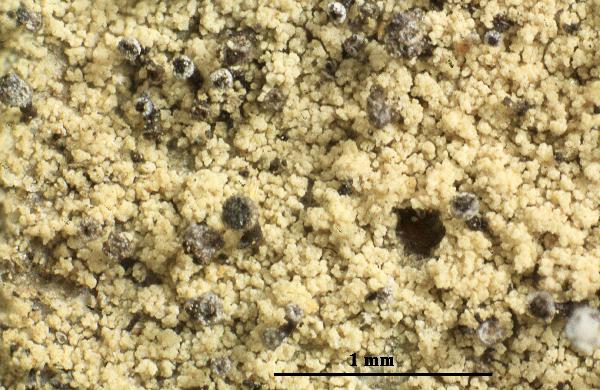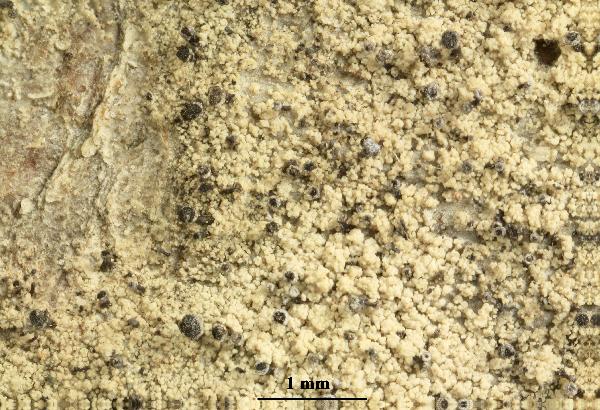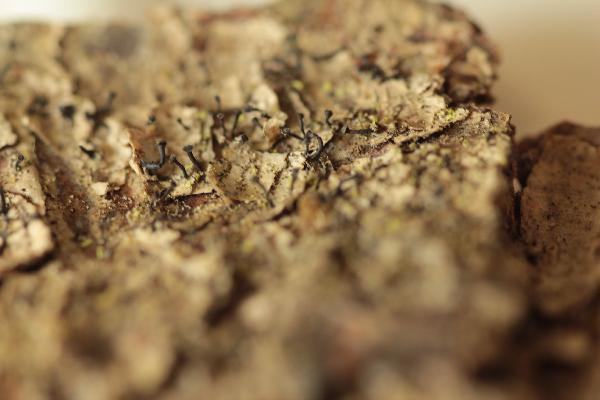Calicium lenticulare Ach.
K. Vetensk.-Akad. Handl.: 262, 1816.
Synonyms: Calicium amylocaule Lettau; Calicium atroviride Körb.; Calicium cladoniscum auct.; Calicium lenticulare var. cladoniscum auct. non Schaer.; Calicium quercinum var. lenticulare (Ach.) Nyl.; Calicium schaereri sensu Nádv. non De Not.; Calicium subquercinum Asahina; Calicium virescens (Schaer.) Hepp
Distribution: N - Frl (Puntillo & Puntillo 2009), Ven (Puntillo & Puntillo 2009), TAA (Nascimbene & al. 2007b, Puntillo & Puntillo 2009, Nimis & al. 2015), Lomb (Puntillo & Puntillo 2009), Piem (Isocrono & al. 2004, Puntillo & Puntillo 2009), Emil Puntillo & Puntillo 2009, Fariselli & al. 2020), Lig (Puntillo & Puntillo 2009). C - Tosc (Puntillo & Puntillo 2009). S- Camp (Garofalo & al. 2010).
Description: Thallus crustose, endosubstratic and poorly evident or more often episubstratic and granular-verrucose, greenish to yellowish grey, sometimes with a bluish tinge. Apothecia long-stalked, pin-like, most often with a whitish pruina on the lower side of capitulum, more rarely epruinose. Stalk black to dark reddish brown, 0.5-1.3 mm high, 0.08-0.22 mm thick, of sclerotized, dark, irregularly interwoven hyphae, in section distinctly reddish brown, sometimes with strands of granular crystals, the outer layer covered with a very thin, transparent, non-amyloid gelatinous sheath. Capitulum narrowly obconical to lenticular, 0.2-0.55 mm across, with a well-developed, cup-shaped exciple of intertwined, sclerotized hyphae; mazaedium well developed, black; hypothecium blackish brown, with a convex upper surface. Asci narrowly clavate to cylindrical, formed singly, dissolving early, with partly 2-seriate ascospores. Ascospores at first simple, then (when released from asci) 1-septate, dark brown, broadly ellipsoid to ellipsoid, (9-)11-12 x (4-)6-7 µm, with a thick, minutely verrucose to areolate wall. Photobiont chlorococcoid. Spot tests: thallus K-, C-, KC-, P-; ascomata I+ deep blue to blue-black in all parts. Chemistry: thallus without lichen substances or with placodiolic and sometimes 4-O-methylhypoprotocetraric acids.
Note: a mainly cool-temperate to boreal-montane, circumpolar species found on lignum of decorticated stumps and trunks of conifers in upland areas, present both in the Alps and along the Apennines, but rare. It is included in the Italian red list of epiphytic lichens as “Critically Endangered” (Nascimbene & al. 2013c).
Growth form: Crustose
Substrata: bark and lignum
Photobiont: green algae other than Trentepohlia
Reproductive strategy: mainly sexual
In underhangs rarely wetted by rain
Commonnes-rarity: (info)
Alpine belt: absent
Subalpine belt: very rare
Oromediterranean belt: absent
Montane belt: extremely rare
Submediterranean belt: absent
Padanian area: absent
Humid submediterranean belt: absent
Humid mediterranean belt: absent
Dry mediterranean belt: absent

Predictive model
Herbarium samples


P.L. Nimis; Owner: Department of Life Sciences, University of Trieste
Herbarium: TSB (5970)
2001/12/05


P.L. Nimis; Owner: Department of Life Sciences, University of Trieste
Herbarium: TSB (9352)
2001/12/05

Felix Schumm- CC BY-SA 4.0
[17164], Brasilien, São Paulo, zwischen São Laurenço und Juquií etwa 65 km W von São Sebastião, am Rio Guaratuba, in einer Mangrove aus Rhizophora mangle und Laguncularia racemosa, an abgestorbenen Bäumen, 1 m, 23°47' S, 45°44' W. Leg. K. Kalb, 19.02.1980, det. L. Tibell. KALB: LICHENES NEOTROPICI 489.

Felix Schumm- CC BY-SA 4.0
[17221], Brasilien, Minas Gerais, Serra do Espinhaço, Serra do Caraça, unterhalb des Klosters Caraça (Hauptsammelgebiet von Vainio im Jahr 1885). An Rinde in einem hellen, feuchten Wäldchen, 1200 m, 20°10' S, 43°30' W. Leg. K. Kalb & G. Plöbst, 08.07.1978, det. L. Tibell,1987. KALB: LICHENES NEOTROPICI 583


Felix Schumm - CC BY-SA 4.0
[VZ1655], U.R.S.S., Transcaucasia, Colchis. Distr. Chota, ad latera
austro-orientalia iugi montium Achun, in valle fluminis Chosta, 400 m.
Ad corticem Fagi orientalis, leg. V Vašák et A. V zda, 15.06.1979. EX
A. V ZDA: LICHENES SELECTI EXSICCATI NR. 1655, distributed as
Calicium subquercinum Asah.


Felix Schumm - CC BY-SA 4.0
[VZ1655], U.R.S.S., Transcaucasia, Colchis. Distr. Chota, ad latera
austro-orientalia iugi montium Achun, in valle fluminis Chosta, 400 m.
Ad corticem Fagi orientalis, leg. V Vašák et A. V zda, 15.06.1979. EX
A. V ZDA: LICHENES SELECTI EXSICCATI NR. 1655, distributed as
Calicium subquercinum Asah.
Growth form: Crustose
Substrata: bark and lignum
Photobiont: green algae other than Trentepohlia
Reproductive strategy: mainly sexual
In underhangs rarely wetted by rain
Commonnes-rarity: (info)
Alpine belt: absent
Subalpine belt: very rare
Oromediterranean belt: absent
Montane belt: extremely rare
Submediterranean belt: absent
Padanian area: absent
Humid submediterranean belt: absent
Humid mediterranean belt: absent
Dry mediterranean belt: absent

Predictive model
| Herbarium samples |


P.L. Nimis; Owner: Department of Life Sciences, University of Trieste
Herbarium: TSB (5970)
2001/12/05


P.L. Nimis; Owner: Department of Life Sciences, University of Trieste
Herbarium: TSB (9352)
2001/12/05

Felix Schumm- CC BY-SA 4.0
[17164], Brasilien, São Paulo, zwischen São Laurenço und Juquií etwa 65 km W von São Sebastião, am Rio Guaratuba, in einer Mangrove aus Rhizophora mangle und Laguncularia racemosa, an abgestorbenen Bäumen, 1 m, 23°47' S, 45°44' W. Leg. K. Kalb, 19.02.1980, det. L. Tibell. KALB: LICHENES NEOTROPICI 489.

Felix Schumm- CC BY-SA 4.0
[17221], Brasilien, Minas Gerais, Serra do Espinhaço, Serra do Caraça, unterhalb des Klosters Caraça (Hauptsammelgebiet von Vainio im Jahr 1885). An Rinde in einem hellen, feuchten Wäldchen, 1200 m, 20°10' S, 43°30' W. Leg. K. Kalb & G. Plöbst, 08.07.1978, det. L. Tibell,1987. KALB: LICHENES NEOTROPICI 583


Felix Schumm - CC BY-SA 4.0
[VZ1655], U.R.S.S., Transcaucasia, Colchis. Distr. Chota, ad latera austro-orientalia iugi montium Achun, in valle fluminis Chosta, 400 m. Ad corticem Fagi orientalis, leg. V Vašák et A. V zda, 15.06.1979. EX A. V ZDA: LICHENES SELECTI EXSICCATI NR. 1655, distributed as Calicium subquercinum Asah.


 INDEX FUNGORUM
INDEX FUNGORUM
 GBIF
GBIF
 DOLICHENS
DOLICHENS








